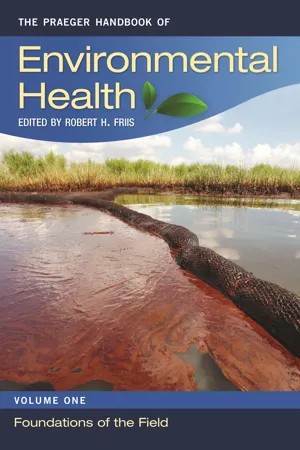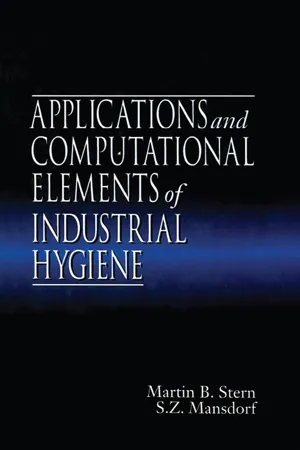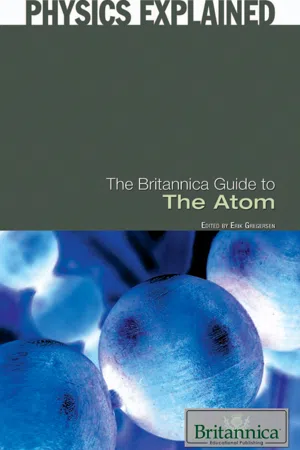Geography
Ionising Radiation
Ionizing radiation refers to high-energy radiation that has enough energy to remove tightly bound electrons from atoms, creating charged particles (ions) in the process. This type of radiation includes alpha and beta particles, gamma rays, and X-rays. It is a natural part of the environment and can also be produced by human activities, with potential impacts on human health and the environment.
Written by Perlego with AI-assistance
Related key terms
Related key terms
1 of 4
Related key terms
1 of 3
12 Key excerpts on "Ionising Radiation"
- eBook - ePub
- U. Aswathanarayna(Author)
- 2018(Publication Date)
- Routledge(Publisher)
CHAPTER 7Natural radiation environment
7.1 IONIZING RADIATIONS
Ionizing radiations are capable of damaging biological tissues, with the nature of damage inflicted being related to the type, energy and penetrating power of the radiation involved. There are essentially two kinds of ionizing radiations: (1) electromagnetic radiations such as x-rays and gamma rays, and (2) corpuscular radiations, such as, alpha particles, beta particles (electrons), protons, neutrons, etc. Alpha particles are large particles, with energies of the order of millions of electron volts (MeV) and a range of 0.01 to 0.07 mm in soft tissues, and less in bone. Beta particles (electrons) are much smaller in size, have energies of the order of kilo electron volts (KeV), and have a range of several millimetres in soft tissues. X-rays and gamma rays are not stopped by tissues.The main natural sources of ionizing radiation in the environment are cosmic rays, and the decay of radioactive elements in rocks, soils, waters and atmosphere. So, wherever we live and whatever we eat and drink, we are being constantly and inexorably exposed to ionizing radiations all our lives. Normally, these radiation levels are so low as to have no ill effects on health. In normal circumstances, the exposure to man-made ionizing radiations is largely through medical examinations and treatment through X-rays. People and environment are occassionally exposed to high doses of man-made ionizing radiations through nuclear accidents (e.g. Three Mile Island reactor accident in USA or the Chernobyl disaster in Ukraine, in the former Soviet Union). Use of radon-bearing gas for cooking purposes, and the use of improperly shielded microwave ovens, etc. could also contribute to exposure to ionizing radations.7.1.1 Terminology of radiation units
The dose of radiation is the amount of energy absorbed per unit mass of material. One RAD (Radiation Absorbed Dose) is 10−2 Joules kg−1 - eBook - ePub
- H A Waldron(Author)
- 2013(Publication Date)
- Butterworth-Heinemann(Publisher)
Chapter 8Ionizing radiation
R.C. HackPublisher Summary
Certain wavelengths of electromagnetic waves and energetic particles are capable of ionizing the matter through which they pass. Such agents are collectively referred to as ionizing radiation. Ionization makes atoms electrically charged by either losing or gaining electrons, and the resultant atoms are known as ions. The resultant deposition of energy causes chemical changes and, hence, biological damage on a microscopic scale. Biological effects can be divided into somatic and hereditary factors. They may also be subdivided into stochastic and non-stochastic effects. This chapter discusses the basic physical concepts, the quantities involved, and the various sources of radiation, both natural and man-made. It describes the various effects of radiation and the risk factors associated with stochastic effects. The chapter also explains the various limits recommended for both occupational exposure and general populations and discusses the basic control methods of radiological protection.Introduction
Certain wavelengths of electromagnetic waves (say, less than 20 nm) and energetic particles are capable of ionizing matter through which they pass. Such agents are collectively referred to as ‘ionizing radiation’. Ionization results in atoms becoming electrically charged by either losing or gaining electrons, the resultant atoms being known as ions. The resultant deposition of energy causes chemical changes and hence biological damage on a microscopic scale. Biological effects (nearly always harmful to the healthy being) may be divided into somatic (that is, affecting the person exposed to the radiation) and hereditary (affecting the descendants of the exposed person). They may also be subdivided into stochastic and non-stochastic effects. A stochastic effect is one in which the probability of the effect occurring is proportional in some way to the exposure with no threshold; the severity of the effect, if it does occur, is independent of the degree of exposure. A non-stochastic effect is one in which the severity of the effect is proportional to the degree of exposure above a threshold value; the effect is certain to occur at exposures above the threshold. Both stochastic and non-stochastic effects caused by low level chronic exposures are usually associated with long latent periods (years to tens of years). - eBook - ePub
Principles of Occupational Health and Hygiene
An introduction
- Sue Reed, Dino Pisaniello, Geza Benke(Authors)
- 2020(Publication Date)
- Routledge(Publisher)
Table 13.1 ).Table 13.1RadiationElectromagnetic wave Particle Ionising Gamma and X–ray Alpha, beta and neutrons Non–ionising Ultraviolet, visible, infrared, radiofrequency, extremely low frequency radiation Electromagnetic waves travel in air and vacuum at the speed (v) of light, 3.0 ´ 108 m/s, and are characterised by their wavelength (l, or l, in metres) and frequency (f, in cycles per second, or hertz (Hz)). Wavelength and frequency are inversely proportional.(Equation 13.1)f = v / λRadiation made up of high-speed particles travels at a range of speeds, and there are various different particle types (e.g. alpha radiation travels at approximately one-twentieth the speed of light and beta radiation travels at close to the speed of light).The first half of this chapter discusses Ionising Radiation, its common sources and its quantification, health effects, measurement and controls. The second half discusses non-Ionising Radiation, which includes ultraviolet, visible, infrared, radiofrequency and extremely low-frequency radiation and static fields. Lasers are also included as a special application of visible, infrared and ultraviolet radiations.13.2 Ionising RadiationThere are two types of Ionising Radiation: electromagnetic and particulate. Figure 13.1 shows these.Figure 13.1Types of Ionising RadiationIonising Radiation occurs naturally and also arises from human-made sources. It has many practical uses. Sealed radiation sources and x-rays are used in industrial and medical applications, and unsealed sources are used in medical, research and radiation-monitoring applications. Over-exposure to Ionising Radiation can cause a range of adverse health effects, including increasing the risk of cancer.13.2.1 ELECTROMAGNETIC Ionising RadiationX-rays and gamma rays are electromagnetic radiation and can be thought of as photons. These types of radiation have the highest energy in the electromagnetic spectrum (see Figure 13.2 - eBook - ePub
- Ben Selinger, Russell Barrow(Authors)
- 2017(Publication Date)
- CSIRO PUBLISHING(Publisher)
Chemistry of Ionising RadiationThis chapter starts with radiation basics, followed by the biological effects of radiation. External sources include NORM (naturally occurring radioactive materials) such as minerals in the garden, limestone caves, mineral beach sands and coal. Radioactivity in food and medical exposure are discussed. We toss in the dramatic story of a hyperactive, radioactive boy scout. The theory that low-level exposure might even have positive effects is not as outrageous as one might at first believe. Of the many applications of radioactive materials, a final example comes from the forensic investigation of art forgery.Radiation both causes cancer and is used to cure cancer. The sun’s rays keep us healthy but burn us, and worse. Radiation is a prime example of the conflict between the two faces of science/technology.Radiation is helpfully split into two categories: non-ionising and ionising, with some overlap. Electromagnetic radiation belongs (at moderate frequencies) to the non-ionising category. Its frequency ranges from radio waves, microwaves, infrared and visible light, all the way out to γ rays (which are, however, so powerful that they are ionising) (Fig. 18.1 ). All this radiation travels at the speed of light (3 × 10 8 m/s). Visible light covers only a very small section of this spectrum and comprises a stream of massless particles called photons.The energy of a photon depends on its wavelength (or frequency). The shorter the wavelength (or higher the frequency) of the radiation, the greater the energy of the photon. The physical and biological effect of a photon depends on its energy (Fig. 18.2 ).On the other hand, the quantity of radiation depends on the intensity (i.e. the number of photons). The very small proportion of ultraviolet radiation in sunlight can cause burning in 10 minutes, while you can spend weeks behind glass without getting a tan because it cuts out the UV, but lets through longer wavelengths.Fig. 18.1. - eBook - ePub
The Praeger Handbook of Environmental Health
[4 volumes]
- Robert H. Friis, Robert H. Friis, Robert H. Friis(Authors)
- 2012(Publication Date)
- Praeger(Publisher)
22 Ionizing Radiation Arthur C. Upton Introduction Life has evolved in the continuous presence of ionizing radiation from natural sources, the existence and potential health effects of which were unknown prior to Roentgen’s discovery of the X-ray in 1895. Shortly thereafter, however, the X-ray was introduced rapidly into medical practice, and within weeks those working with the early radiation equipment began to report the occurrence of inflammatory reactions of the skin on their hands. In the ensuing years, various other types of radiation injuries were reported, including the first case of cancer attributed to ionizing radiation (see Table 22.1). During the century since then, study of the health effects of ionizing radiation has received continuing impetus from the expanding uses of radiation in medicine, science, industry, and the peaceful and military applications of atomic energy. The in-depth knowledge of the effects of ionizing radiation that has been gained as a result has been of strategic importance in the development of measures for protection against the harmful effects of radiation and other environmental agents. Physical Properties and Dosimetry of Ionizing Radiation Ionizing radiation differs from other forms of radiant energy in being able to deposit enough localized energy in atoms and molecules on which it impinges to break chemical bonds and give rise to ions and free radicals. The ionizing forms of radiation include (a) electromagnetic radiations of extremely short wave length and high energy (e.g., X-rays and gamma rays) (see Figure 22.1), and (b) particulate radiations, which vary in mass and charge (e.g., electrons, protons, neutrons, alpha particles, and other atomic particles). The distribution of such ionizing events along the path of the radiation in an absorbing medium—that is, the quality, or linear energy transfer (LET), of the radiation—varies with the energy and charge of the radiation, as well as the density of the absorbing medium - eBook - ePub
Nuclear Facilities
A Designer's Guide
- Bill Collum(Author)
- 2016(Publication Date)
- Woodhead Publishing(Publisher)
Everything around us reflects visible radiation, which we can see and differentiate as various colors. Having said that, the visible light we perceive sits between infrared and ultraviolet, which are just outside our range of vision. Apparently dogs, if they are to be believed, can hear higher pitched sounds than we do. Nevertheless, even they cannot view the full range of colors that are out there, and neither can we. So radiation contributes to how we see the world around us, but this is just one facet of something with properties so strange it is barely believable.It is quite remarkable that a single entity, tuned in different ways, can carry a radio program or TV picture, cook our dinner, enable us to differentiate colors and use mobile phones. It can give us a suntan or X-ray, be harnessed to make weapons or provide electricity, and either cause cancer or help to cure it. Offhand I cannot think of anything else that is quite so diverse, particularly when we consider how utterly intangible it is.2.3 Nonionizing radiation
Nonionizing radiation does not have the same energy levels as ionizing radiation, so it does not have the power to do physical damage. It surrounds us all the time and includes infrared and ultraviolet radiation, visible light, microwaves, and radio waves.2.4 Ionizing radiation
Ionizing radiation is so called because it has sufficient energy to cause an electron to leave the orbit of an atom. As an electron hurtles away at the speed of light, two things happen very quickly indeed: it instantly changes its name to an ion , and electrical balance within the atom left behind shifts to become positively charged, or ionized .Ionizing radiation is the one normally visualized when radiation is contemplated. It has enough energy to break chemical bonds or to strip electrons from atoms. It is in this branch of radiation that we find alpha and beta particles, gamma rays, and X-rays, but that's not all. We are well aware that over exposure to direct sunlight can cause skin cancer, which means we can add the higher frequencies of ultraviolet radiation, given off by the sun, to our list of ionizing radiations. It too has sufficient energy to break chemical bonds. It is a good example, if we needed one, that visible light really is part of the same family as other types of radiation. - eBook - ePub
Principles of Occupational Health and Hygiene
An introduction
- Sue Reed, Dino Pisaniello, Geza Benke, Kerrie Burton(Authors)
- 2020(Publication Date)
- Routledge(Publisher)
13. Radiation—ionising and non-ionisingRoy Schmid and Michelle Wakelam13.1 Introduction 13.2 Ionising Radiation 13.2.1 Electromagnetic Ionising Radiation 13.2.2 Particulate Ionising Radiation 13.2.3 International and national legislative framework 13.2.4 Sources of Ionising Radiation 13.2.4.1 Background radiation from natural sources 13.2.4.2 Background radiation from human-made sources 13.2.4.3 Categories of human-made radiation sources 13.2.5 Exposure categories 13.2.6 Properties of Ionising Radiation 13.2.6.1 Interaction with matter 13.2.6.2 Penetrating vs. ionising ability 13.2.7 External and internal hazard 13.2.7.1 External hazard 13.2.7.2 Internal hazard 13.2.8 Quantifying radiation 13.2.8.1 Activity 13.2.8.2 Radiological half-life 13.2.8.3 Energy 13.2.9 Quantifying exposure and dose 13.2.9.1 Absorbed dose and exposure 13.2.9.2 Equivalent dose and radiation weighting factor 13.2.9.3 Effective dose and tissue weighting factor 13.2.9.4 Biological half-life and effective half-life 13.2.9.5 Committed dose, dose coefficient and limits of intake 13.2.10 Health effects of Ionising Radiation 13.2.10.1 Radiation sickness and death 13.2.10.2 Skin effects 13.2.10.3 Effects on the eyes 13.2.10.4 Reproductive system and hereditary effects 13.2.10.5 Effects on the unborn child 13.2.10.6 Cancer 13.2.10.7 Diseases other than cancer 13.2.11 Dose limits (exposure standards) 13.2.12 Detecting Ionising Radiation 13.2.12.1 Types of measurement 13.2.12.2 Types of instrument 13.2.12.3 Choice of a monitoring instrument 13.2.12.4 Calibration and performance checking 13.2.12.5 Monitoring techniques 13.2.13 Controlling radiation hazards 13.2.13.1 Minimising external exposure 13.2.13.2 Minimising internal exposure 13.3 Non-Ionising Radiation 13.3.1 Ultraviolet radiation - eBook - ePub
Harmful Natural Chemicals and Radiation in the Environment
Stories, History and What You Need to Know
- Raymond Poon(Author)
- 2012(Publication Date)
- WSPC(Publisher)
CHAPTER 12 EFFECT OF IONIZING RADIATION ON HEALTH”We must bear in mind that all of us are continuously inhaling the radium and thorium emenations and their products and ionized air. In addition, we are continuously undergoing a type of mild X-ray treatment for the β and γ rays from the Earth and atmosphere that continuously pass into and through our bodies.”Ernest Rutherford (1871-1937)1Natural Source of ExposureThe crust of the earth has contained radioactive materials ever since its creation. The earth is also continuously bombarded by high-energy particles which originated in outer space. Throughout lives, humans are exposed to four sources of natural radiation: Cosmic, external/terrestrial, inhalation and ingestion (Table 1 ).Cosmic radiation The origin of cosmic radiation is summarized below:2 ,3 ,741. Galactic cosmic radiation. Cosmic ray originates from deep space outside the solar system. High energy cosmic particles impinging on the earth’s atmosphere interacted with atoms and molecules in the air and generated sets of secondary, less energetic, charged and uncharged particles. At ground level, muons (energetic charged particles similar to electrons but with a heavier mass) are the most important contributor to radiation dose, while neutrons, electrons, positrons, photons and protons are the most significant components at aircraft altitude. The earth’s geomagnetic field deflects charged cosmic ray towards the magnetic poles, which is the reason why cosmic radiation is more intense near the North and South poles.74 At time of maximum solar activity, which occurs on an approximately 11-year cycle, the galactic cosmic radiation is at its lowest.83Table 1 . Estimated Average Annual Dose (mSv) of Natural Radiation Received by Man.2. Solar cosmic radiation. Magnetic disturbance on the Sun’s surface ejects energetic particles, mostly in the form of protons. Some of these particles reach the Earth and contributed to the total intensity of cosmic radiation. During the height of a solar storm, when high concentrations of energetic solar particles reach the Earth, aircrew and passengers may receive a dose of about 1 mSv per subsonic fligh.9 In other times, however, solar flares do not have sufficient energy to significantly increase the intensity of cosmic radiation at commercial aircraft altitude.74 - eBook - ePub
- Jack K Horner(Author)
- 2021(Publication Date)
- Routledge(Publisher)
Most current radiation protection standards or proposals explicitly take existing sources of ionizing radiation into consideration. This only makes sense, because an exposure ceiling more restrictive than, say, the exposure produced by the natural background, would be impractical to enforce. Regulatory agencies, furthermore, must often attempt to determine whether a proposed or actual practice will "significantly" increase the radioactive burden already present in the environment; making such a determination typically requires knowing something about the magnitude of both natural background radiation field and the consequences of human redistribution of, and contributions to, that field. This section surveys the contributions known to be made by each of those phenomena.External irradiation from the natural background
External irradiation is defined as exposure of man to radioactive sources which lie outside of the human body. The natural background of ionizing radiation contributes significantly to the total external irradiation dose experienced by man. External irradiation comes comes from the earth itself and from high-energy cosmic radiation entering the earth's atmosphere from space.External irradiation from cosmogenic sources . The high-energy radiation which enters the earth's atmosphere from space is called primary cosmic radiation . This radiation consists largely of highenergy protons from interstellar regions, together with 4 He ions (which constitute about 10% of the total primary particle flux) and very small proportions of heavier particles, electrons, photons, and neutrinos. The primary cosmic radiation flux density is strongly affected by the earth's magnetic field, which deflects low-energy charged particles back into space; this deflection is dependent on geomagnetic latitude, being strongest at the poles and weakest in equatorial regions.The origin of primary cosmic rays is still not completely known. Calculations show that most of the primary cosmic radiation in the upper atmosphere could have originated in our own galaxy. Those primary cosmic rays which do arise within our galaxy are called galactic cosmic rays ; the sun also produces primary cosmic rays, called solar cosmic rays - Martin B. Stern, Zack Mansdorf(Authors)
- 2018(Publication Date)
- CRC Press(Publisher)
Ionizing radiation can be divided into four broad categories: electromagnetic radiation, energetic electrons (beta radiation), energetic heavy ions (e.g., alpha radiation, protons, fission fragments), and neutrons. To be classified as ionizing radiation, each photon or particle must have enough kinetic energy to ionize matter. About 12 eV is sufficient energy to remove an electron from an atom, creating an ion (ionization).Electromagnetic radiation may be described as either waves or massless quanta called photons. Ionizing radiation begins in the high-energy portion of the ultraviolet light band, at about 12 eV (100 nm wavelength). Photons with greater energy (shorter wavelength) than ultraviolet light are called X-rays when they originate from the electron shell of an atom, and gamma rays when they originate from the atomic nucleus.Beta radiation consists of high-energy electrons emitted from the nucleus during radioactive beta decay. Beta radiation can be negatively charged electrons or positively charged electrons (positrons).Alpha radiation consists of high-energy particles ejected from the atomic nucleus during alpha decay. An alpha particle is made of two protons and two neutrons and is identical to the nucleus of a helium atom.Energetic heavy ions such as protons and fission fragments are ionizing radiation, and are encountered in particle accelerators and nuclear reactors respectively.Neutrons are subatomic particles with no electric charge and a mass of 1 atomic mass unit (amu). High-energy neutrons will ionize matter. A special characteristic of neutron radiation is that stable matter can become radioactive when neutrons are absorbed (neutron activation).B. RadioactivityAll atoms can be divided into two categories: radioactive and nonradioactive (stable). Radioactive atoms are the same as nonradioactive matter except that they have an additional characteristic: they will spontaneously decay or transmute, releasing energy and emitting ionizing radiation.To be clear, radioactivity is matter. Radiation is emitted when a radioactive atom decays. When a radioactive atom decays or transmutes, the resulting atom is (almost always) an atom of a different element.- Edward W. Finucane(Author)
- 2023(Publication Date)
- CRC Press(Publisher)
Ionizations produced by this class of electromagnetic radiation can occur either “directly” or “indirectly”. “Directly” ionizing radiation includes:- electrically charged particles (i.e., electrons, positrons, protons, α-particles, etc.), and
- photons/particles of sufficiently great kinetic energy that produce ionizations by colliding with atoms and/or molecules present in the matter.
- liberating one or more “directly” ionizing particles from matter with which these particles have interacted or are penetrating, or
- initiating some sort of nuclear transition or transformation (i.e., radioactive decay, fission, etc.) as a result of their interaction with the matter through which these particles are passing.
Protection from the adverse effects of exposure to various types of Ionizing Radiation is an issue of considerable concern to the occupational safety and health professional. Certain types of this class of radiation can be very penetrating (i.e., γ-rays, X-rays, and neutrons); that is to say these particles will typically require very substantial shielding in order to ensure the safety of workers who might otherwise become exposed. In contrast to these very penetrating forms of Ionizing Radiation, α- and β-particles are far less penetrating, and therefore require much less shielding.Categories of Ionizing Radiation
Cosmic Radiation
Cosmic Radiation (cosmic rays) makes up the most energetic — therefore, potentially the most hazardous — form of Ionizing Radiation. Cosmic Radiation consists primarily of high speed, very high energy protons (protons with velocities approaching the speed of light) — many or even most with energies in the billions or even trillions of electron volts. These particles originate at various locations throughout space, eventually arriving on the earth after traveling great distances from their “birthplaces”. Cataclysmic events, or in fact any event in the universe that liberates large amounts of energy (i.e., supernovae, quasars, etc.), will be sources of Cosmic Radiation- eBook - ePub
- Britannica Educational Publishing, Erik Gregersen(Authors)
- 2010(Publication Date)
- Britannica Educational Publishing(Publisher)
Considerably more knowledge about the biologic effects of neutrons had been acquired by the time the first nuclear reactor was built in 1942 in Chicago. The nuclear reactor, which has become a prime source of energy for the world, produces an enormous amount of neutrons as well as other forms of radiation. The widespread use of nuclear reactors and the development of high-energy particle accelerators, another prolific source of ionizing radiation, have given rise to health physics. This field of study deals with the hazards of radiation and protection against such hazards. Moreover, since the advent of spaceflight in the late 1950s, certain kinds of radiation from space and their effects on human health have attracted much attention. The protons in the Van Allen radiation belts (two doughnut-shaped zones of high-energy particles trapped in Earth’s magnetic field), the protons and heavier ions ejected in solar flares, and similar particles near the top of the atmosphere are particularly important.UNITS FOR MEASURING IONIZING RADIATION
Ionizing radiation is measured in various units. The oldest unit, the roentgen (R), denotes the amount of radiation that is required to produce 1 electrostatic unit of charge in 1 cubic centimetre of air under standard conditions of pressure, temperature, and humidity. For expressing the dose of radiation absorbed in living tissue, the principal units are the gray (Gy; 1 Gy = 1 joule of radiation energy absorbed per kilogram of tissue) and the rad (1 rad = 100 ergs per gram of tissue = 0.01 Gy). The sievert (Sv) and the rem make it possible to normalize doses of different types of radiation in terms of relative biologic effectiveness (RBE), because particulate radiations tend to cause greater injury for a given absorbed dose than do X-rays or gamma rays. The dose equivalent of a given type of radiation (in Sv) is the dose of the radiation in Gy multiplied by a quality factor that is based on the RBE of the radiation. Hence, one sievert, defined loosely, is that amount of radiation roughly equivalent in biologic effectiveness to one gray of gamma rays (1 Sv = 100 rem). Because the sievert and the rem are inconveniently large units for certain applications, the milligray (mGy; 1 mGy = 1/1000 Gy) and millisievert (mSv; 1 mSv = 1/1000 Sv) are often substituted.
Index pages curate the most relevant extracts from our library of academic textbooks. They’ve been created using an in-house natural language model (NLM), each adding context and meaning to key research topics.
Explore more topic indexes
Explore more topic indexes
1 of 6
Explore more topic indexes
1 of 4











